Verbascum, Mullein
High Taper, Torchweed, Taxus barbatusMao Rui Hua (TCM)
Busir (Unani)
Gyug pa’i gser bye གགྱུག་པའི་གསེར་བྱེ (Tibet)
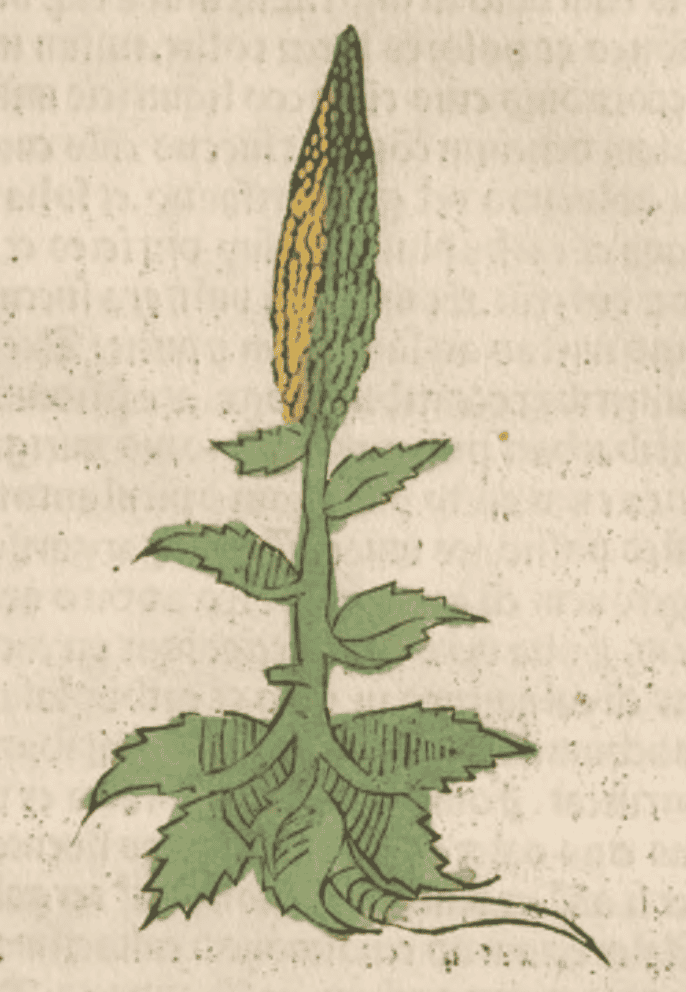 Taxus barbatus
Taxus barbatusHerbarius latinus, Petri, 1485 |
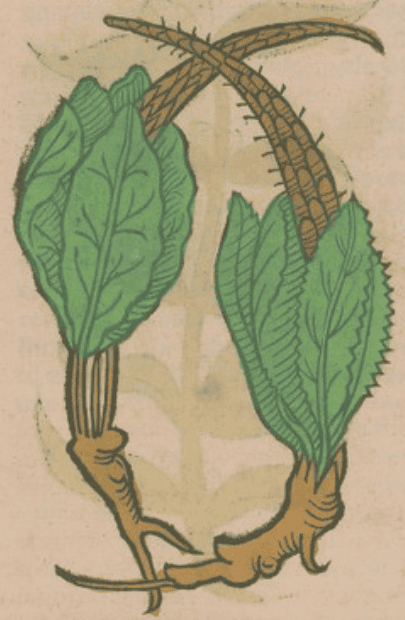 Tapsus
TapsusOrtus Sanitatis, Meydenbach, 1491 |
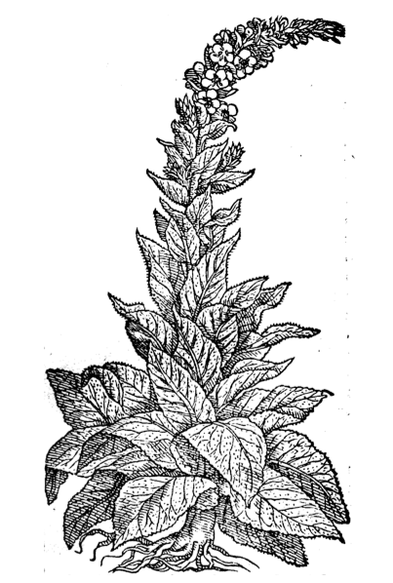 Della Materia Medicinale Andrea Valuassori, 1562
Della Materia Medicinale Andrea Valuassori, 1562 |
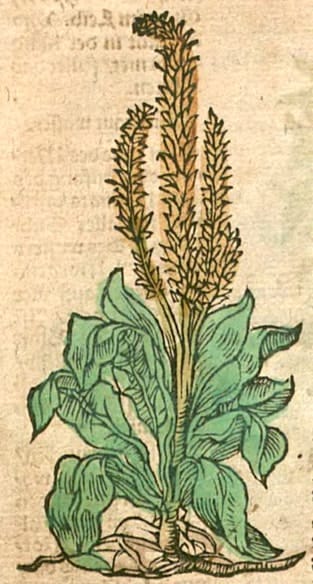 Kurtzes Handtbuchlein, Ryff, 1599
Kurtzes Handtbuchlein, Ryff, 1599 |
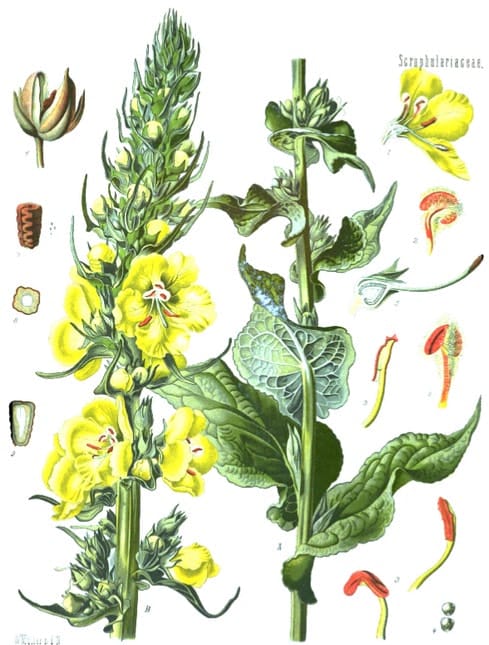 Koehler’s Medizinal Pflanzen, 1887
Koehler’s Medizinal Pflanzen, 1887Botanical name:
Verbascum thapsus (syn. V. thapsiforme), V. phlomoides
Various local species are used including V. lasianthum., V. speciosum (Turkey), V. nubicum (Egypt), V. altanticum (Algeria)
It has been used in TCM (Mao Rui Hua) but is a rarely used medicine.
Parts used:
Leaf; Flower; Root
Seed is used in Tibetan Medicine
Temperature & Taste:
Neutral, dry. Sweet, Bitter
Classifications:
2L. EMOLLIENT. 2Q. ANODYNE
3L. ANTI-TUSSIVE
Uses:
1. Clears Heat and Phlegm, Moistens Dryness, Stops Coughs: (West, Tibet, TCM)
-“Coughs, Ulcers of the Lungs, Spitting of Blood, Asthmas” (Salmon).
-“The decoction is useful in chronic Cough“. (Avicenna)
–Culpeper listed it for old Coughs; used old, hacking and spasmodic Coughs, unproductive Cough, chronic Bronchitis
-Asthma, Emphysema, Consumption, Blood in the Sputum; Pneumonia (TCM)
-Congestion, Sinusitis, Hay Fever, especially when used in the form of an inhalation.
2. Clears Phlegm, Resists Poison, Resolves Swellings: (West, Tibet, TCM)
-‘The decoction of the root and the leaves, is of great effect to dissolve the tumors, swellings, or inflammations of the Throat’ (Culpeper)
-Tonsillitis, Malignant Sore Throat, and various swellings and tumors of the throat (internally, and as a gargle);
-Scrofula, Lymphadenitis, various Nodes, Tumors and Cancer; Toxic Sores in TCM
-chronic appendicitis in TCM.
-root is an effective Febrifuge, effective in various Fevers (decocted in water and wine)
-Also for Chicken Pox, Measles and Mumps
3. Nourishes the Sinews, Stop Wind and Spasms:
-stiffness of the Sinews, Cramps, Convulsions (esp. Root); inflammatory conditions of the bones, sinews and joints
-Epilepsy; most used for Convulsion and Epilepsy in children
4. Clears Heat, Stops Leakages and Bleeding:
-leakages or bleeding from the Lungs or Bowels;
-painful Diarrhea, and Dysentery, with or without blood.
-listed by Gerard as being ‘good for them that are broken internally’. (Often decocted in Red wine)
5. Benefits the Heart and Circulation, Moves the Blood:
-Palpitations, irregular heartbeats and Angina.
-varicose veins and ulcers.
-Long used for the pain and swelling of Hemorrhoids.
6. Clears Heat and Damp, Promotes Urine:
-promotes Urine, helps clear Gravel and Stones;
-inflammation or irritation of the Urinary system, Orchitis, Chronic Cystitis, and Painful Urination.
-internally and externally for Rheumatic condition.
7. Tonic:
-Potter, in his Compend of Materia Medica (1902) said ‘highly praised as a substitute for Cod-liver Oil in phthisis and other wasting diseases’. (decocted in Milk or taken with Honey for this purpose)
8. Externally:
-“The decoction of the leaves of Mullein is useful in Swelling, Wounds and Ulcers. It is mixed with Honey and used as a plaster”. (Avicenna)
-leaves boiled in Vinegar and applied to Foul Sores and Ulcers, as well as various Swellings and Tumors.
-juice is rubbed onto Warts
-juice was used to draw Thorns and Splinters from the flesh
-catarrhal Deafness, degeneration of hearing
-Earache, Sores and Ulcers of the Ear.
-wash or poultice for heat and swelling of the Eyes (flowers steeped in Rose Water is good).
-mouthwash eases Toothache (esp. Root decoction). (Avicenna)
-contracted Sinews and Rheumatic complaints
-‘The seed bruised and boiled in wine, and laid on any member that has been out of joint, and newly set again, takes away all swelling and pain’ (Culpeper).
-Ashes of the herb made into a wash restore Grey hair to its original color.
Dose:
1. Decocted in Milk for chest or bowel disorders including bleeding of these organs, and to nourish the Yin.
2. Decocted in Wine for pain, inflammation and to move the Blood, both internally and externally.
3. Decocted in Vinegar for topical application to Swellings and Tumors and acute Sore Throat.
INFUSION or BRIEF DECOCTION of the Leaf: 3–9 grams, up to 15 grams. The Decoction or Infusion may be taken freely, and it may be decocted in Milk or Wine;
INFUSION of the FLOWERS: 2–7 grams, usually 1 teaspoon;
TINCTURE (1:2 in 25% alcohol): 4–12 mls, 2–3 times daily;
FLUID EXTRACT (1:1 in 25% alcohol): 3–9 mls;
POWDER of the LEAF: 300mg–1.5 grams, up to 3 grams, 2–4 times daily.
Used externally in oils, plaster, poultices, ointments and in douches, enemas and baths. As an enema for Intestinal infections, or to clean the bowels, a handful of the mixed leaves and flowers, fresh or dried, may be simmered, then steeped, strained and used.
Main Combinations:
1. Cold, Flu, acute Cough, the flowers of Mullein, Linden, Violet, Poppy, Coltsfoot, Mallow, Marshmallow (as in Infusion of Seven Flowers)
2. Cough:
i. Mullein, Coltsfoot
ii. Mullein with Plantain and Licorice
iii. Mullein with Licorice, Marshmallow (Ulrich)
iv. Mullein, Hyssop, Coltsfoot, Marshmallow root, Licorice
v. Dry Cough, Mullein, Marshmallow, Violet, Licorice
vi. Chronic Cough, Mullein with Rue
vii. Chronic Cough, Mullein, Comfrey root, Licorice (1 oz. each), Thyme (half oz.). Simmer the first 3 herbs in 3 pints of water for half an hour. Strain and pour hot onto the Thyme and infuse, then strain again and keep.
viii. sore Throat, Hoarseness, Mullein with Fennel seed (Hildegard)
3. Whooping Cough:
i. Mullein, Hyssop, Raisins, Licorice
ii. Mullein, Peppermint, Cowslip, Soapwort, Violet root, Thyme
4. Bronchitis:
i. Mullein with Horehound and Coltsfoot
ii. Mullein with Elecampane and Yarrow
iii. Mullein with Coltsfoot and Lance-leaf Plantain (Müller)
iv. acute Cough and Bronchitis, Mullein with Coltsfoot, Marshmallow root, Aniseed (Weiss)
5. Croup:
i. Mullein, Thyme, Aniseed
ii. Mullein, Elecampane, Elder flower, Hyssop
6. Asthma:
i. Mullein with Thyme
ii. Mullein with Coltsfoot, Calamus, Asarum, Juniper berry
7. Hemoptysis or Consumption:
i. Mullein with Comfrey
ii. Mullein, Comfrey, Plantain, Shepherd’s Purse
8. Diabetes, peeled Acorn, Sweet Almonds (6 of each), Infusion of Mullein (6 oz.), Syrup of Ground Ivy (1 oz.). Mix. Take every evening. (Formulaire de Montpellier, 1822)
9, Cancer:
i. Mullein with Figwort, Mullein root, Filipendula, Agrimony, Tormentil, Elder flower, Rosemary and Nettle seed (as in Decoction for Cancer)
10. Worms, Mullein juice, with leaves or bark of Walnut, Nettle juices, Vinegar and Honey (Hildegard)
11. Fomentation for bleeding Hemorrhoids, Mullein with Yarrow, Plantain, Elder leaf and Pomegranate peel
12. Wash for Stiffness and Cramps, Mullein with Sage, Marjoram and Camomile
13. Fomentation for Pleurisy, Mullein, Marshmallow, Pellitory of the Wall (Herbarium Horstianum, 1630)
Major Formulas:
Infusion of Seven Flowers
Decoction for Cancer (Fuller)
Universal Vulnerary Decoction (Joseph Du Chesne)
Pectoral Powder
Warming Pearl Powder (Diamargariton Calidum) (Avicenna)
Powder to Purge in Ascites (Nicholas)
1. Emollient Powder
Mullein Flower
Marshmallow Flower
Mallow Flower
Pellitory of the Wall
Cautions:
Generally Safe.
Seed and fresh root are toxic in large doses.
Main Preparations used:
Distilled water of the Flowers, Infused Oil of the Flowers (repeated several times)
-
Extra Info
- Research
